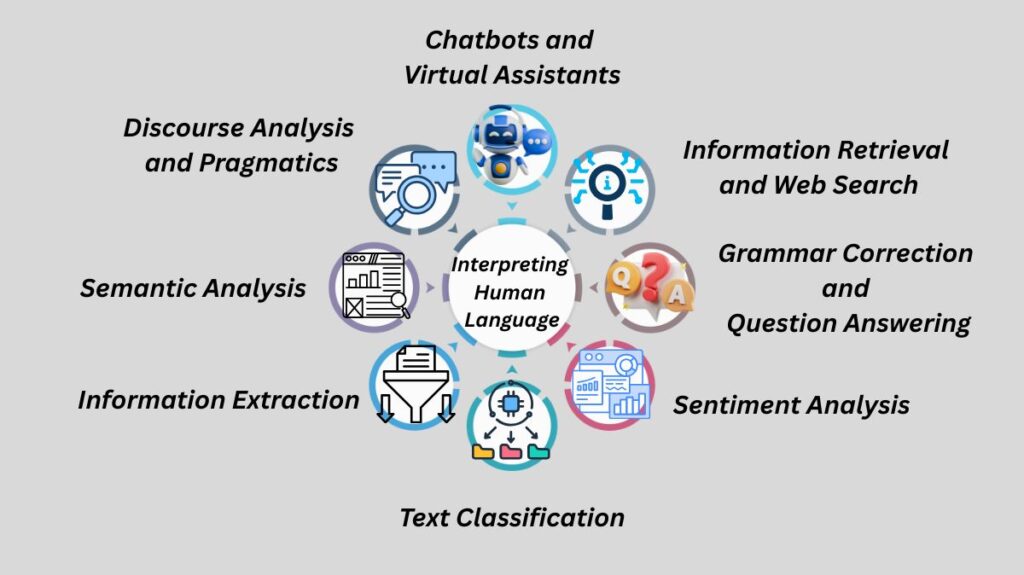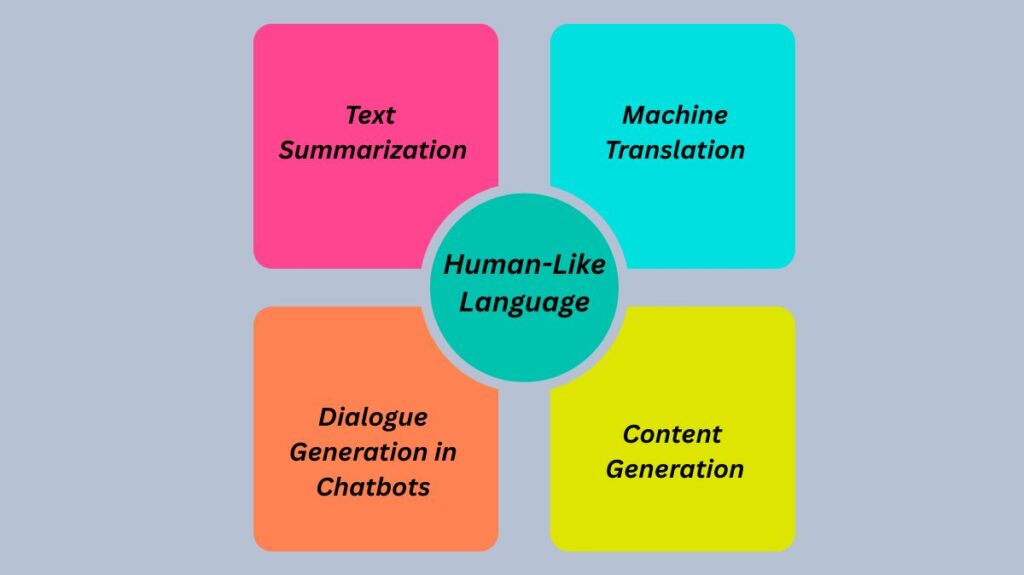Real World Applications of NLP
Natural Language Processing (NLP) is revolutionising human-computer interaction and machine comprehension and processing of human language through its diverse range of applications. The sources illustrate a wide range of applications that are fuelled by developments in deep learning and machine learning across several fields. Below is a thorough breakdown of several important NLP applications:
Understanding and Interpreting Human Language

Chatbots and Virtual Assistants: NLP allows chatbots and virtual assistants to understand client questions, provide information, perform tasks, and provide personalised suggestions. These systems analyze speech or text input to extract relevant information by evaluating user intent. Customer care chatbots, Alexa, and Siri are a few examples. Over time, they frequently use learning processes and feedback to enhance their conversational skills.
Information Retrieval and Web Search: Using NLP approaches is essential to increasing search engine relevance and accuracy. Search engines like Google and Bing are able to deliver more accurate results than merely keyword matches by translating user requests into meaning. Understanding the background and purpose of the search phrases is part of this.
Grammar Correction and Question Answering: NLP gives systems the ability to recognize and fix grammatical mistakes in text. By integrating information retrieval and natural language processing (NLP) techniques, question answering systems are able to comprehend natural language enquiries and offer accurate responses.
Sentiment Analysis: NLP approaches use text analysis to identify the sentiment or emotional tone (e.g., neutral, negative, or positive) that is being communicated. The industry makes extensive use of this to monitor brand reputation, interpret consumer input, and assess public opinion. Geographic sentiment mapping is another application for it.
Text Classification: NLP is used to group text according to its content into pre-established categories. Among the uses are language identification, document routing, and spam screening. Before digesting a document, search engines also utilise it to determine its language.
Information Extraction: By automatically extracting structured information from unstructured text, NLP seeks to achieve its goal. Finding key words, determining links between named entities (such as persons, organizations, or places), and identifying named entities themselves can all be part of this process. Complex biological information extraction from text is the main goal of BioNLP.
Semantic Analysis: NLP methods examine how words, phrases, and sentences are understood. This is essential for things like comprehending user enquiries, relating user needs to information, and enhancing online ontologies. Word Sense Disambiguation (WSD), which seeks to determine a word’s accurate meaning in a particular context, is one of the jobs it also involves.
Discourse Analysis and Pragmatics: NLP examines the context of a conversation or document in order to comprehend language beyond individual sentences. Tasks like determining what pronouns refer to and comprehending the discourse relationships between various textual elements are included in this.
Generating Human-Like Language

Text Summarization: Automatically, NLP can provide succinct summaries of lengthier texts. Key sentences may be extracted, or fresh writing that highlights the essential ideas may be created.
Machine Translation: The automatic translation of voice or text between languages is made possible by natural language processing (NLP), which is essential to machine translation. Attention-mechanism encoder-decoder designs are frequently used in contemporary methods. On top of that, NLP helps with CLIR (cross-language information retrieval).
Dialogue Generation in Chatbots: Natural Language Generation helps conversational bots provide replies that are logical and pertinent to the situation. It is necessary for these systems to interpret human input and create responses that sound realistic.
Content Generation: Text in many formats, including reports, news stories, and even creative writing, may be produced using natural language processing (NLP). Healthcare and educational applications seek to give consumers useful information.
Speech Recognition
Speech Recognition (Speech-to-Text): Writing down spoken words requires the use of natural language processing (NLP). Applications that employ speech interfaces, dictation software, and voice assistants all use this. Typically, deep learning and Hidden Markov Models (HMMs) are employed for this job.
Text-to-Speech: Additionally, NLP is employed in the other direction, translating written material into spoken language.
Other Applications of NLP
Auto-Correct and Spelling Correction: Errors in spelling are automatically found and fixed in text using natural language processing techniques.
Language Detection: A text’s language can be determined using natural language processing (NLP).
Applications in Finance and Law: In these fields, natural language processing (NLP) is being utilised more and more for tasks like evaluating legal and financial materials.
Machine Translation Aids: For the benefit of human translators, NLP offers features and tools.
Lexicography: The development and upkeep of lexicons and dictionaries are facilitated by NLP technologies.
Information Visualization: NLP can improve data visualization by adding annotations to give context or by spatially mapping text data.
Education and Healthcare: The goal of NLG applications is to enhance health and education results. One particular field that focusses on applications in biology and medicine is called BioNLP.
Market Intelligence: NLP may be used to examine text data for consumer insights and market trends.
Computer-aided language learning: These kinds of apps employ speech recognition.
Data entry and dictation: These activities are made easier by speech recognition.
Command and control: Voice instructions may be understood and responded to by systems with NLP.
Voice dialing and call routing: Among these applications is speech recognition.
Code and Model Reproducibility, Troubleshooting, and Interpretability: NLP research also focusses on creating systems that are reliable and comprehensible. Explainable AI (XAI) methods are applied to comprehend how NLP models make decisions.
Minimizing Technical Debt and Automating Machine Learning in NLP: Continuous work is being done to make the creation and implementation of NLP systems more efficient.
The growth of NLP applications, which use methods ranging from rule-based systems to complex deep learning models, is fuelled by improvements in both comprehending and producing human language. The ultimate objective is to make human-machine communication more efficient and natural.
